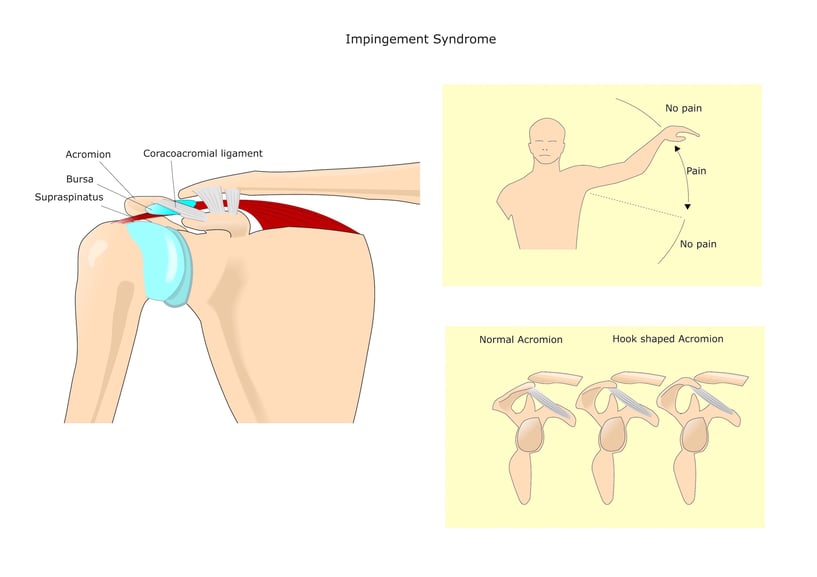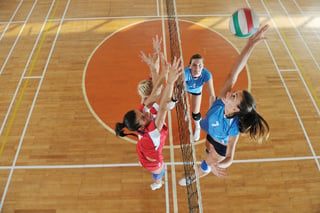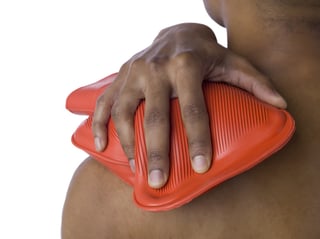Search for topics or resources
Enter your search below and hit enter or click the search icon.
August 15th, 2016 | 2 min. read


Shoulder impingement syndrome is a common cause of shoulder pain that may affect anyone who performs repeated reaching and lifting over their heads.
Also known as subacromial impingement syndrome, it occurs deep inside the shoulder, when the bones of the shoulder blade and upper arm chafe against the top of the rotator cuff.
The term Shoulder Impingement Syndrome refers to a situation in which the tendons and bursa (fluid-filled sac) in the shoulder are repeatedly pinched between the upper arm bone (humerus) and your shoulder blade (scapula).
Over time, this pinching may cause inflammation, swelling, and pain, as well as more serious conditions like tendonitis, bursitis, rotator cuff tears, SLAP lesion tears, and bone spurs.
How does shoulder impingement happen?
At the top of the shoulder blade, a bony projection, called the acromian, curves over the knob of the upper arm bone. Between these bones a narrow channel exists, called the subacromial space.
Within this space are the tendons that make up the upper rotator cuff, as well the bursa, which provides valuable cushioning within the shoulder joint.
When you raise and lower your arms, this subacromial space compresses naturally, impinging (or pushing) the bursa and tendons up against the bottom of the acromian bone.
Repeated compressions of this narrow channel can sometimes lead to shoulder impingement syndrome, which is also known as subacromial impingement syndrome — literally, “under the acromian bone.”

The classic signs of impingement syndrome are as follows:
An especially good test for this condition is to hold the arm straight out to the side, and then raise it 30 degrees above and then 30 degrees below shoulder level (see above image). If this movement produces significant pain, you may be suffering from shoulder impingement syndrome.
Impingement syndrome can occur in anyone. However, it is most likely to develop in athletes in sports that require repeated, forceful overhand motions. Swimmers, tennis players, volleyball players, and baseball pitchers are especially susceptible.
 Other possible causes include:
Other possible causes include:
Surgery is rarely needed to ease shoulder impingement syndrome. Most patients respond well to the following effective treatments:

After a few days of these treatments, you may consult with a doctor or physical therapist for gentle stretching and strengthening exercises. These will improve your range of motion and firm up your rotator cuff muscles, both of which
are essential for restoring your shoulder to normal.
If your condition does not improve, you may be suffering from more extensive shoulder problems, such as a torn rotator cuff or a bone spur. Your doctor will counsel you on the best option for treatment.
To learn more about shoulder pain, treatment options, and shoulder conditioning programs, give Coastal Orthopedics located in Corpus Christi, TX a call.Telephone: 361.994.1166.
Article written by: Rob Williams, MD
Dr. Williams has been practicing orthopedic surgery in Corpus Christi since 1998. After graduating from Texas Tech hereceived his medical degree from the University of Texas at San Antonio. At the prestigious Campbell Clinic located at the University of Tennessee, Dr. Williams completed not only an Orthopedic Surgery Residency, but an additional year of Fellowship Training in Spine Surgery. Dr. Williams is dedicated to creating an excellent patient experience in the office or in the surgery suite.
Topics: